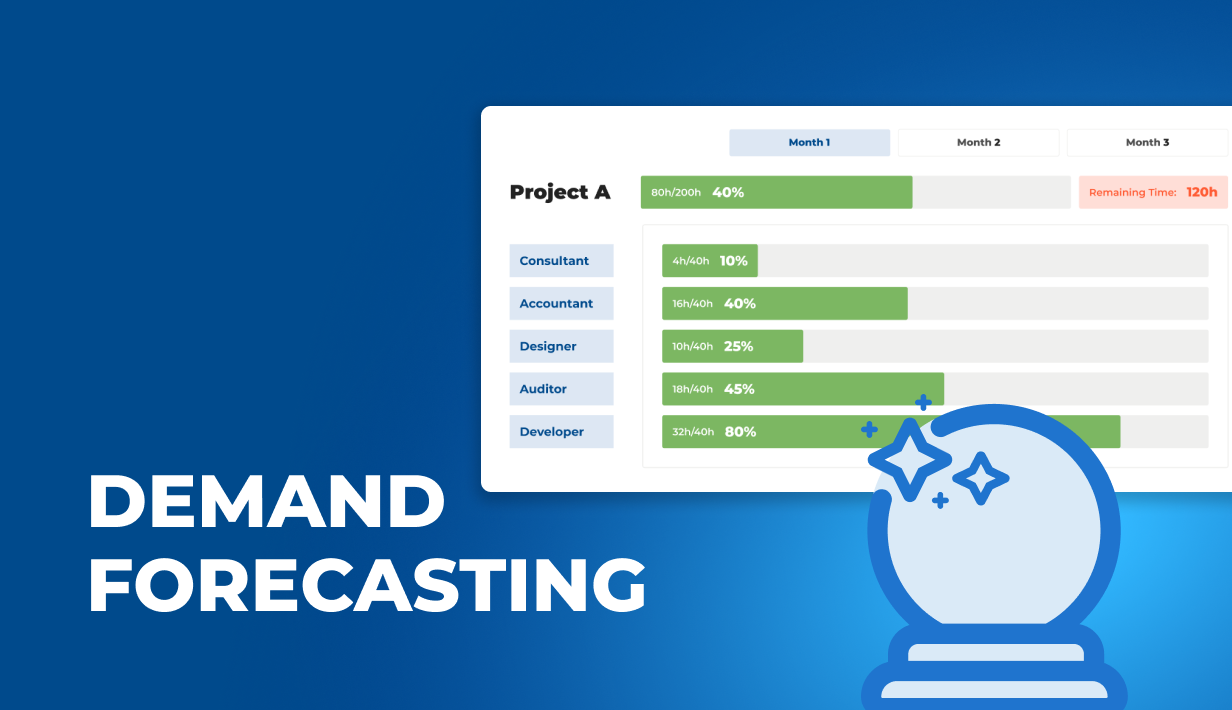Over 45% of professional services projects go over budget before they end. A cost overrun is not only a burden for a project manager but also for the entire company. Here’s how you can prevent this problem from happening in the first place.
What is a cost overrun?
Cost overrun (or budget overrun) is a situation where the actual costs of a given operation exceed the planned budget.
Cost Overrun Definition
Cost overrun can be defined as:
- A percentage of the total expenditure
- A total percentage including and above the original budget
- A percentage of the cost overruns to the original budget
Cost Overrun Examples
There are a few typical examples of cost overrun in a project budget that are particularly common for the professional services industry. They include:
- Fixed-price projects running out of money because of too much work being done.
- Retainer projects underestimating monthly workload and, therefore, spending too much money.
- Time and material projects that go over the budget limit for a given time.
What is the difference between cost overrun and cost escalation?
Cost overrun is usually a surprise for those who experience it — it simply appears out of nowhere.
Cost escalation, on the other hand, is taken into account long before the project starts. In other words, it is anticipated that some costs in the project (usually a long-term one) are going to grow with time, and that change is included in the cost estimation for the project.
What are the main causes of cost overrun?
The main causes of cost overrun include fluctuations in cost and project scope.
Changes in wages, time off, project scope, and numerous little daily tasks we tend to overlook may significantly impact cost overrun. Of course, a short holiday taken by one employee probably won’t ruin your project; however, when combined with additional tasks suddenly ordered by the customer, it can really take a toll on financial results and leave a project manager with few options.
Below we outline other common causes of cost overruns.
Hidden Costs
It’s often thought that the costs in project management are limited to technology and wages. Unfortunately, that is an incorrect assumption. That’s because the profits from the project should also cover:
- Project overheads, both one-time and recurring, such as subscriptions, additional devices, delegations, and more.
- Company overheads, including the cost of support departments (marketing, sales, etc.), costs of rent, utilities, costs of project management itself, etc.
- Additional operations that were initially not included in the project scope.
- The length of the project. The longer the project, the greater the chances its profitability will drop with time. Therefore, you should consider potential changes in its scope to ensure that the project remains profitable.
Of course, these hidden costs are inevitable. However, they should not be ignored and left to chance. Otherwise, the project may not be profitable in the end.
How to Keep Track of Hidden Costs and Avoid Cost Overruns
Solving the problem of hidden and unexpected costs in projects is fairly easy. It usually starts with simple time tracking that compares the project’s scope with actual data. Timesheets based on the tracked hours will show you exactly how much time was spent on different tasks and, when combined with information on wages, how much they cost.
However, to monitor the actual profit margin for every project and prevent cost overruns, project managers must also gather all the information about finances in resource management software.
The software should also be able to distinguish between project costs and company overheads to show the managers exactly what their profits are and what they can improve about their project management.
Incorrect Estimates
Every project budget starts as a cost estimate based on the basic deliverables, and it is the backbone of the project’s success. Of course, to accurately predict the budget, managers need a resource forecasting process that can help them assess the costs of work to come. Then, they have to take other critical costs into account.
Sounds simple? It may sound that way, but inaccurate project estimates are one of the main causes of cost overrun, which may ruin the project plan and put the entire project management team in a difficult position.
There are a few reasons why estimates do not reflect the reality of work. In general, they include:
- An assumption that every part of the project will go as planned.
- Unexpected costs that weren’t included in the risk management plan by a project manager.
- Lack of knowledge of similar past projects, leading to incorrect estimates.
- Unclear deliverables that include unnecessary actions or omit the ones that are crucial for the project.
- Unrealistic project deadlines or unexpected project changes that cause a difference between actual cost and planned cost of a task.
- Lack of fixed wages depending on the specialization and seniority of the employee.

How to Fix Incorrect Estimates and Prevent Cost Overruns
Creating correct estimates largely depends on the skills and experience of the person who makes them in the first place. Their knowledge of the project life cycle and dependencies in the company can make their forecasts much more accurate. Therefore, choosing the right manager for the job is the key to preventing cost overruns.
However, valuable input from an experienced project manager is not the only thing that can help you improve the financial estimates in your project. You can also:
- Consult the most experienced specialists who have worked on similar projects before to improve the accuracy of estimates.
- Cooperate with all the stakeholders to cover all the deliverables in a project at the estimation phase.
- Determine what to do in case some estimates turn out to be incorrect.
- Leave some room for error in the budget.
- Estimate the workload for parts of the project instead of the entire project using average hourly incomes or average costs of similar phases in other projects.
By improving your estimates, you can improve the condition of the entire company and prevent cost overruns.
Project Scope Creep
Of course, even the best project scope may start to change as the work in the project progresses. Such a situation is called scope creep and may take a huge toll on the project budget, especially when the workload grows exponentially. As a result, the sum of wages also rises, and so do all the other expenses, causing an inevitable cost overrun, putting the project’s success at risk.
What causes scope creep in the first place?
Scope creep is generally caused by a series of errors made in the planning phase. The most common ones are:
- Underestimating the complexity of a project or omitting some parts of it.
- Communication problems with stakeholders.
- Incorrect estimates for the time and costs of different operations in the project.
Naturally, all of these problems may cause a cost overrun. So, what can we do about them?
How to Avoid the Problem of Scope Creep
Let’s start with the basics. Just like in any other type of work, in the professional services industry, communication is key (even though it can sometimes be underestimated). Therefore, you should spare no effort to ensure that your customer knows what they want and can present you with all the information you need to create an accurate project scope to avoid cost overrun.
Make sure that you understand the project’s requirements correctly and whether your team can ensure progress, as well as a positive project outcome. Discuss the operation with your team and customer to outline the work as accurately as possible and summarize each key point and its costs to prevent cost overrun. Then, present the results of your analysis to your customer before moving on.
Last but not least, monitor the project as it progresses, as project cost overrun can happen at any stage of work. Keep track of the time specialists spend on different phases and the costs, check the budget for unexpected overheads, and ensure that wages stay within the budget.
Performance Failures
Let’s be honest — anything can happen over the course of a project. Sometimes, an important specialist has to take a few sick days, other times, a mundane task takes longer than expected. There are, however, thousands of different situations that may have a negative impact on a project’s performance and cause a huge cost overrun.
What is the main cause of performance failures?
Depending on the type of the project, performance failures affecting the original project budget may originate from different sources. In the professional services industry, they usually include:
- Unrealistic project timeline.
- Problems with resource management, including scheduling conflicts.
- Absence or lack of specialists with crucial skills for a given phase of the project.
- Incorrect or interwoven dependencies.
- Lack of project milestones or other metrics that can be used to measure progress.
Of course, any of these scenarios may result in delays or additional work being required, contributing to a cost overrun.
How to React to Performance Failures
Unfortunately, performance failures sometimes cannot be avoided — often, they are a matter of sheer bad luck. However, we can prepare for them by calculating the project risks and leaving some room for error in the budget and the resource plan. By doing so, project managers can ensure they will stay within the budget, even when things go south, and avoid cost overrun altogether.
Of course, risk management is also vital in that case. Before the project starts, try to establish dependencies between the task and pay particular attention to those likely to cause trouble later on. Then, adjust your teams’ schedules accordingly to give them some room for error.
Last but not least, project managers should always stay on top of their projects so they can react to unexpected occurrences and calculate cost overruns on a regular basis. A quick reaction may save you from a project failure!
How to Prevent Cost Overrun
Luckily, cost overrun may be prevented before it wreaks havoc on your project. Here are some things you can do to avoid being trampled by growing costs and deliver a successful project.
Use Cost Allocation Key Formula
The profitability of your project depends not only on the work and equipment involved but also on the costs of other endeavors your commercial operations need to cover. To determine the real costs associated with a given project, you need to assign a portion of the general expenses to it using a cost allocation key formula.
Of course, the fraction of the additional cost depends on the size of the project in question or its expected profits. This formula allows you to assign costs proportionally without forcing smaller projects to cover the enormous costs.
Track Both Billable and Non-Billable Hours
Internal work may sometimes be essential, but in some cases, it may just be the source of additional costs. To make things worse, it can sometimes escape a manager’s attention, as it is often (wrongfully) considered free. Non-billable hours still require money for wages and equipment — that’s why you should also track the time spent on internal work.
Standardize the Calculations for Utilization and Profitability
Depending on their knowledge, experience, and background, each manager may have a different way of calculating utilization and profitability, and they may take different factors into account when doing so. That may lead to confusion and wrong decisions.
Fortunately, there is a simple solution to that problem. Before you start measuring different indicators, whether profitability or utilization, make sure that all your managers use the same formula for their calculations. This way, you can easily compare all the data and create a reliable base for all future decisions.

Use Your Experience to Create Estimates
Accurate estimates and plans are the key to accurate budgeting, as they specify the amount and cost of work in the first place. Therefore, you should pay maximum attention to how they are created.
To improve your estimates, you should:
- Use similar tasks and processes to forecast the cost and time of the new estimates to increase the chances of success.
- Work closely with both stakeholders and experienced specialists in your company.
- While making estimates, leave some room for error and unexpected situations, such as absences or delays.
- Keep track of the wages and salaries during the resource planning process.
- Include overheads and other costs in your forecasts.
Monitor the Project Progress
Project managers should not lose focus once the project is planned, as changes to the scope of work are almost inevitable — especially in long-term operations. Therefore, they need to monitor the work daily to ensure that there are no unexpected obstacles that may interfere with the project and cause a cost overrun.
To keep track of the project’s progress, managers should regularly check:
- The amount of hours worked on the project (paying particular attention to overtimes, delays, or absences).
- The cost of work done on the project in a given period.
- Whether any additional tasks or resources are required for the project to progress.
- The general budget of the project, including project and organizational overheads.
- Settlements and payments.
Using this information, project managers can react to any arising issues, preventing the project from going over budget and becoming unprofitable.
In addition, resource management software like BigTime can combine all of the information above, turning them into more valuable insights — all in a fully automated way that is visible across an entire organization.





